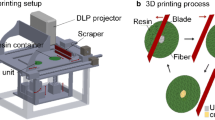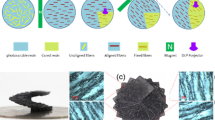Abstract
In the natural composites, the reinforcement particles are subtly organized into complex structures in matrix, and its various microstructures endow the biomaterials with a variety of excellent mechanical behaviors. Among the various reinforcement building blocks used in biomaterials, short fibers are the most ubiquitous reinforcement elements. Unfortunately, because of the limitation of fabrication technique, replication of these fiber-reinforced biological composites can be extremely difficult in practice. In this paper, we developed a fiber assembly 3D printing process, which can manipulate the orientation of fibers during 3D printing procedure. Benefiting from this technology, the reinforcement particles were manipulated remotely and the arrangement of reinforcement particles with higher degree of freedom was achieved. Subsequently, based on the herringbone-modified helicoidal architecture of mantis shrimp, the bio-inspired composites with various microstructures were reconstructed by 3D magnetic printing. In addition, the influence of microstructure type and parameters of bio-inspired composites on the properties of composites was studied systematically, and the quantitative relationship between microstructure and properties of the composites was established. The results show that the impact resistance and compression resistance of the composites can be significantly improved by the simple internal microstructures design, and the regression model established in this article can be used for accurate prediction of composites properties and the reliability is higher. In a word, this study opens a new route for the design of composites with unusual features.











Similar content being viewed by others
References
Wegst UG, Bai H, Saiz E et al (2015) Bioinspired structural materials. Nat Mater 14(1):23–36
Jackson AP, Vincent JFV, Turner RM (1988) The mechanical design of Nacre. Proc R Soc Lond 234(1277):415–440
Weaver JC, Milliron GW, Miserez A et al (2012) The stomatopod dactyl club: a formidable damage-tolerant biological hammer. Science 336(6086):1275–1280
Grunenfelder LK, Suksangpanya N, Salinas C et al (2014) Bio-inspired impact-resistant composites. Acta Biomater 10(9):3997–4008
Weiner S, Wagner HD (1998) The material bone: structure-mechanical function relations. Annu Rev Mater Res 28(1):271–298
Zhao C, Liu Q, Ren L et al (2016) A 3D micromechanical study of hygroscopic coiling deformation in Pelargonium, seed: from material and mechanics perspective. J Mater Sci 52(1):1–16. https://doi.org/10.1007/s10853-016-0341-6
Yang C, Huang HX, Li K (2010) Investigation of fiber orientation states in injection-compression molded short-fiber-reinforced thermoplastics. Polym Compos 31(11):1899–1908
Morales E, White JR (2009) Effect of ageing on the mechanical properties and the residual stress distribution of hybrid clay–glass fibre–polypropylene injection mouldings. J Mater Sci 44(17):4734–4742. https://doi.org/10.1007/s10853-009-3733-z
Chrysostomou A, Hashemi S (1998) Mechanical properties of injection moulded styrene maleic anhydride (SMA) Part II Influence of short glass fibres and weldlines. J Mater Sci 33(18):4491–4501. https://doi.org/10.1016/s0266-3538(01)00062-8
Akay M, Barkley D (1991) Fibre orientation and mechanical behaviour in reinforced thermoplastic injection mouldings. J Mater Sci 26(10):2731–2742. https://doi.org/10.1007/BF00545562
Estevez L, Kelarakis A, Gong Q et al (2011) Multifunctional graphene/platinum/Nafion hybrids via ice templating. J Am Chem Soc 133(16):6122–6125
Scholz MS, Drinkwater BW, Trask RS (2014) Ultrasonic assembly of anisotropic short fibre reinforced composites. Ultrasonics 54(4):1015–1019
Yaraghi NA, Guarín-Zapata N, Grunenfelder LK et al (2016) A sinusoidally architected helicoidal biocomposite. Adv Mater 28(32):6835–6844
Compton BG, Lewis JA (2014) 3D-printing of lightweight cellular composites. Adv Mater 26(34):5930–5935
Yang Y, Chen Z, Song X et al (2017) Biomimetics: biomimetic anisotropic reinforcement architectures by electrically assisted nanocomposite 3D printing. Adv Mater. https://doi.org/10.1002/adma.201770076
Llewellyn-Jones TM, Drinkwater BW, Trask RS (2016) 3D printed components with ultrasonically arranged microscale structure. Smart Mater Struct 25(2):02LT01
Kokkinis D, Schaffner M, Studart AR (2015) Multimaterial magnetically assisted 3D printing of composite materials. Nat Commun 6(1):8643
Martin JJ, Caunter A, Dendulk A et al. (2017) Direct-write 3D printing of composite materials with magnetically aligned discontinuous reinforcement[C]//SPIE Defense + Security. pp 101941I
Martin JJ, Fiore BE, Erb RM (2015) Designing bioinspired composite reinforcement architectures via 3D magnetic printing. Nat Commun 6(1):8641
Mirica KA, Ilievski F, Ellerbee AK et al (2011) Using magnetic levitation for three dimensional self-assembly. Adv Mater 23(36):4134–4140
Shi D, He P, Zhao P et al (2011) Magnetic alignment of Ni/Co-coated carbon nanotubes in polystyrene composites. Compos B Eng 42(6):1532–1538
Stanier DC, Ciambella J, Rahatekar SS (2016) Fabrication and characterisation of short fibre reinforced elastomer composites for bending and twisting magnetic actuation. Compos A Appl Sci Manuf 91:168–176
Efimov Oleg (1983) Probability theory and mathematical statistics. Mir, Moscow
Hadjieva M, Stoykov R, Filipova T (2000) Composite salt-hydrate concrete system for building energy storage. Renew Energy 19(1–2):111–115
Liu J, Tian Y, Chen Y et al (2010) A surface treatment technique of electrochemical oxidation to simultaneously improve the interfacial bonding strength and the tensile strength of PAN-based carbon fibers. Mater Chem Phys 122(2–3):548–555
Varga C, Miskolczi N, Szakács H et al (2011) Effects of industrial scale production on the chemical composition of novel coupling agents and its relationship to the mechanical properties of chopped glass fibre mat reinforced thermoset composites. Mater Des 32(1):12–20
Yao HB, Fang HY, Wang XH et al (2011) ChemInform abstract: hierarchical assembly of micro-/nano-building blocks: bioinspired rigid structural functional materials. Chem Soc Rev 40(46):3764–3785
Naleway SE, Porter MM, Mckittrick J et al (2015) Structural design elements in biological materials: application to bioinspiration. Adv Mater 27(37):5455–5476
Fratzl Peter, Weinkamer Richard (2007) Nature’s hierarchical materials. Prog Mater Sci 52(8):1263–1334
Chen PY, Mckittrick J, Meyers MA (2012) Biological materials: functional adaptations and bioinspired designs. Prog Mater Sci 57(8):1492–1704
Meyers MA, Chen PY, Lin YM et al (2008) Biological materials: structure and mechanical properties. Prog Mater Sci 53(1):1–206
Meyers MA, Chen PY (2013) Structural biological materials: critical mechanics-materials connections. Science 339(6121):773–779
Chen B, Peng X, Cai C et al (2006) Helicoidal microstructure of Scarabaei cuticle and biomimetic research. Mater Sci Eng A 423(1–2):237–242
Apichattrabrut T, RaviChandar K (2006) Helicoidal composites. Mech Adv Mater Struct 13(1):61–76
Chen B, Peng X, Wang JG et al (2004) Investigation of fiber configurations of chafer cuticle by SEM, mechanical modeling and test of pullout forces. Comput Mater Sci 30(3):511–516
Suresh S (2001) Graded materials for resistance to contact deformation and damage. Science 292(5526):2447–2451
Fan DY, Chen YH (1996) Probability theory and mathematical statistics. Zhejiang University Press, China, p 215
Cui W, Li X, Zhou S et al (2010) Investigation on process parameters of electrospinning system through orthogonal experimental design. J Appl Polym Sci 103(5):3105–3112
Acknowledgements
The authors thank the supported by Jilin Province Key Scientific and Technological Project (No. 20170204061GX) and Jilin Provincial Science and Technology Development Project (No. 20150623024TC-01).
Author information
Authors and Affiliations
Corresponding authors
Electronic supplementary material
Below is the link to the electronic supplementary material.
Rights and permissions
About this article
Cite this article
Ren, L., Zhou, X., Liu, Q. et al. 3D magnetic printing of bio-inspired composites with tunable mechanical properties. J Mater Sci 53, 14274–14286 (2018). https://doi.org/10.1007/s10853-018-2447-5
Received:
Accepted:
Published:
Issue Date:
DOI: https://doi.org/10.1007/s10853-018-2447-5




